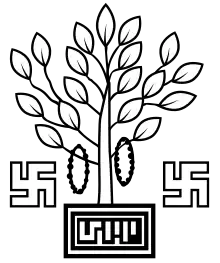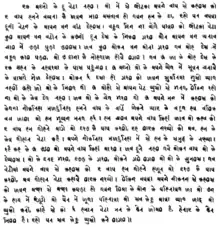| Part of a series on the |
| Culture of Bihar |
|---|
 |
| Society |
| Topics |
|
| Symbols |
Most of the languages of Bihar, the third most populous state of India, belong to the Bihari subgroup of the Indo-Aryan family. Chief among them are Bhojpuri, spoken in the west of the state, Maithili in the north, Magahi in center around capital Patna. Maithili has official recognition under the Eighth Schedule to the Constitution of India.[1] The official language of Bihar is Modern Standard Hindi,[2] with Standard Urdu serving as a second official language in 15 districts.[3]
Exact speaker numbers for the main Bihari languages are not known because the more educated prefer to speak in Hindi (in formal situations) and so return this answer on the census, while many in rural areas and the urban poor, especially the illiterate, list their language as "Hindi" on the census as they regard that as the term for their language.[4]
Other languages include the Indo-Aryan languages like Sadri, Surjapuri, Bengali and Kochila Tharu; the Dravidian languages Kurukh (84,000 speakers in 2011), Kulehiya/Malto (76,000) and Mal Paharia, as well as the Austroasiatic languages Santali (almost half a million speakers in 2011) and Munda.[5]
History
The first success of spreading Modern Standard Hindi occurred in Bihar in 1881, when it displaced Standard Urdu as the sole official medium of the province. In this struggle between Hindi and Urdu standards of the Hindustani language, the potential claims of the three large mother tongues in the region – Bhojpuri, Maithili and Magahi were ignored. After independence, Hindi was again given the sole official status through the Bihar Official Language Act, 1950. Urdu became the second official language in the undivided State of Bihar on 16 August 1989.
Official languages
Hindi is the official languages of the State.[6] Urdu is the second official language of the state.
Hindi
Recognised languages
Maithili
Maithili (/ˈmaɪtɪli/;[7] Maithilī) is an Indo-Aryan language native to India and Nepal. In India, it is widely spoken in the Bihar.[8][9] Native speakers are also found in other states and union territories of India, most notably in Jharkhand and the National Capital Territory of Delhi.[10] According to Ethnologue, there are about 12 million Maithili speakers in India as per 2011 Census.[11] However, in the 2011 census of India, It was reported by only 1,35,83,464 people as their mother tongue comprising about 1.12% of the total population of India,[12] as many Maithili speakers view it as a dialect of Hindi and report their mother tongue as Hindi. In Nepal, it is spoken in the eastern Terai, and is the second most prevalent language of Nepal.[13] Tirhuta was formerly the primary script for written Maithili. Less commonly, it was also written in the local variant of Kaithi.[14] Today it is written in the Devanagari script.[15]
In 2003, Maithili was included in the Eighth Schedule of the Indian Constitution as a recognised regional language of India, which allows it to be used in education, government, and other official contexts.[16]
Other languages and dialects of Bihar
Angika
Angika is mainly spoken in Anga area which includes Munger, Bhagalpur and Banka districts of Bihar and the Santhal Pargana division of Jharkhand.[17] Its speakers are estimated to be around 15 million.[18] In addition to the Anga area, it is also spoken in some parts of Purnia district of Bihar.[19]
Bajjika
Bajjika or Western Maithili is spoken in eastern India and Nepal. It is considered to be a dialect of the Maithili language.[20] Bajjika is spoken in the north-western part of Bihar which mostly spans the modern day Tirhut Division and thus is also referred to as Tirhutiya. In Bihar, it is mainly spoken in the Samastipur, Sitamarhi, Muzaffarpur, Vaishali, Sheohar districts. It is also spoken in a part of the Darbhanga district adjoining Muzaffarpur and Samastipur districts.[21]
Researcher Abhishek Kashyap (2013), based on the 2001 census data, estimated that there were 20 million Bajjika speakers in Bihar (including around 11.46 illiterate adults).[22]
Bhojpuri
Bhojpuri has several dialects: Southern Bhojpuri, Northern Bhojpuri, Western Bhojpuri, and Nagpuria.[23]
Southern Standard Bhojpuri is prevalent in the old Shahabad district (Buxar, Bhojpur, Rohtas, and Kaimur districts) and the Saran region (Saran, Siwan and Gopalganj,east and west Champaran districts) in Bihar, and the eastern Azamgarh (Ballia and Mau districts) and Varanasi (eastern part of Ghazipur district) regions in Uttar Pradesh. The dialect is also known as Kharwari. It can be further divided into Shahabadi, Chhaprahiya and Pachhimahi.[24]
Northern Bhojpuri is common in the western Tirhut division (east and west Champaran districts) in Bihar, and Gorakhpur division (Deoria, Kushinagar, Gorakhpur, and Maharajganj districts) and Basti division (Basti, Sidharthanagar, and Sant Kabir Nagar districts) in Uttar Pradesh. It is also spoken in Nepal.[25]
Western Bhojpuri is prevalent in the areas of Varanasi (Varanasi, Chandauli, Jaunpur, and the western part of Ghazipur district), Azamgarh (Azamgarh district), and Mirzapur, Sonbhadra, Sant Ravidas Nagar, and Bhadohi districts) in Uttar Pradesh. Banarasi is a local name for Bhojpuri, named after Banaras. Other names for Western Bhojpuri include Purbi and Benarsi.[26]
Nagpuria Bhojpuri is the southernmost popular dialect, found in the Chota Nagpur Plateau of Jharkhand, particularly parts of Palamau and Ranchi. It has been influenced more by the Magahi language than by other dialects.[27][25] It is sometimes referred to as Sadri.[28]
Tharu Bhojpuri is spoken by many ethnic Tharu, living in West Champaran district, adjoining Chitwan district of Nepal.[29][30]
A more specific classification recognises the dialects of Bhojpuri as Bhojpuri Tharu, Domra, Madhesi, Musahari, Northern Standard Bhojpuri (Basti, Gorakhpuri, Sarawaria), Southern Standard Bhojpuri (Kharwari), and Western Standard Bhojpuri (Benarsi, Purbi).[31]
Magahi
Magahi is spoken in the Magadh region in southern Bihar. Its heartland is Patna, Jehanabad, Nalanda, Gaya, Nawada and Sheikhpura districts, with the centres of Magahi culture being Patna, earlier called Pataliputra, and Gaya. In the west, in western Patna district, Arwal and Aurangabad districts, Magahi blends into Bhojpuri spoken across the Son river. Across the Ganga Magahi borders various dialects closely related to Maithili. In the east, in Lakhisarai and Jamui districts, Magahi blends into Angika.[32]
Khortha
Khortha language is spoken in far-southern Bihar adjoining Jharkhand, on the Chota Nagpur plateau. Districts where Khortha is spoken include Aurangabad, Gaya, Nawada and Jamui.[33]
Santali
Santhali is a Munda language spoken by the Santhal Adivasis in its heartland in Santhal Parganas in northeastern Jharkhand. As an extension of this population, Santhali is spoken by many people in Jamui, Banka, Munger and Bhagalpur districts. Many Santhali people were also brought to eastern Bihar (Purnia division) as agricultural workers, so large numbers are also found in Araria, Purnia, Katihar and Kishanganj districts.
Surjapuri
Surjapuri is a language variety spoken in Purnia division (Araria, Purnia, Katihar and Kishanganj districts), and adjoining areas of West Bengal, although it has been clubbed under Hindi in the census. In fact, it is more closely related to Assamese and Bengali than Hindi, being the western extension of the Kamatpuri group of dialects like Rajbanshi in neighbouring Nepal and Rangpuri in nearby Bangladesh. In the west it blends with eastern dialects of Maithili.
Classical languages of Bihar
Pali
Sanskrit
Writing systems
See also
References
- ↑ "Constitutional provisions relating to Eighth Schedule" (PDF). Archived from the original (PDF) on 5 March 2016. Retrieved 28 May 2016.
- ↑ "The Bihar Official Language Act, 1950" (PDF). Cabinet Secretariat Department, Government of Bihar. 1950. Archived (PDF) from the original on 13 April 2015. Retrieved 9 April 2015.
- ↑ Benedikter, Thomas (2009). Language Policy and Linguistic Minorities in India: An Appraisal of the Linguistic Rights of Minorities in India. Münster: LIT Verlag. p. 89. ISBN 978-3-643-10231-7. Archived from the original on 19 October 2015. Retrieved 10 April 2015.
- ↑ Jain, Danesh; Cardona, George (2003). The Indo-Aryan Languages. Routledge. p. 500.
The number of speakers of Bihari languages are difficult to indicate because of unreliable sources. In the urban region, most educated speakers of the language name either Hindi or Urdu as their language because this is what they use in formal contexts and believe it to be the appropriate response because of unawareness. The uneducated and the rural population of the region regards Hindi or Urdu as the generic name for their language.
- ↑ List of languages based on:
- "C-16 Population By Mother Tongue – Bihar". Census of India 2011. Office of the Registrar General. Archived from the original (XLSX) on 2020-02-21. Retrieved 14 March 2020.
- "India". Ethnologue. 2023. Ethnologue also lists the following languages as spoken in the state: Awadhi, Braj, Ho, Kanjari, Koch, Koda, Korwa, Kurmukar, Mahali, Munda, Nepali, Newar, Sindhi, Sora.
- ↑ "The Bihar Official Language Act, 1950" (PDF). Cabinet Secretariat Department, Government of Bihar. 1950. Archived (PDF) from the original on 13 April 2015. Retrieved 9 April 2015.
- ↑ "Maithili". Oxford English Dictionary (Online ed.). Oxford University Press. (Subscription or participating institution membership required.)
- ↑ "मैथिली लिपि को बढ़ावा देने के लिए विशेषज्ञों की जल्द ही बैठक बुला सकते हैं प्रकाश जावड़ेकर". NDTVIndia.
- ↑ "मैथिली को भी मिलेगा दूसरी राजभाषा का दर्जा". Hindustan.
- ↑ "BJP trying to influence Maithil voters in delhi | मैथिल मतदाताओं को मोहने की कोशिश में है बीजेपी, दिल्ली में हैं कुल 40 लाख वोटर्स| Hindi News, बिहार एवं झारखंड". zeenews.india.com.
- ↑ "Maithili". Archived from the original on 30 July 2017. Retrieved 1 June 2017.
- ↑ Rise in Hindi language speakers, Statement-4 Retrieved on 22 February 2020
- ↑ Sah, K. K. (2013). "Some perspectives on Maithili". Nepalese Linguistics (28): 179–188.
- ↑ Brass, P. R. (2005). Language, Religion and Politics in North India. Lincoln: iUniverse. ISBN 0-595-34394-5. Retrieved 1 April 2017.
- ↑ Yadava, Y. P. (2013). Linguistic context and language endangerment in Nepal. Nepalese Linguistics 28: 262–274.
- ↑ Singh, P., & Singh, A. N. (2011). Finding Mithila between India's Centre and Periphery. Journal of Indian Law & Society 2: 147–181.
- ↑ Masica, Colin P. (1993). The Indo-Aryan Languages. Cambridge University Press. p. 12. ISBN 978-0-521-29944-2.
- ↑ Sevanti Ninan (2007). Headlines From the Heartland: Reinventing the Hindi Public Sphere. SAGE Publications. p. 61. ISBN 978-0-7619-3580-3. Archived from the original on 11 May 2018.
- ↑ "The Record News". dsal.uchicago.edu. Archived from the original on 3 September 2014.
- ↑ Ethnologue: Maithili
- ↑ Abhishek Kashyap (2014). "On the linguistic resources of Bajjika". In Vibha Chauhan (ed.). The People's Linguistic Survey of India. Vol. 6: The Languages of Bihar. Orient Blackswan. p. 1.
- ↑ Abhishek Kashyap 2014, pp. 1–2.
- ↑ Trammell, Robert Lee (1968). The phonology of the Northern standard dialect of Bhojpuri. OCLC 64035989.
- ↑ Map of Southern Standard Bhojpuri Archived 1 March 2014 at archive.today Digital Library of Language Relationships (2012)
- 1 2 Shaligram Shukla (1981), Bhojpuri Grammar, Georgetown University School of Language, ISBN 978-0878401895
- ↑ Western Standard Bhojpuri Archived 1 March 2014 at archive.today Digital Library of Language Relationships (2012)
- ↑ Parable of the prodigal son in Nagpuria Bhojpuri Archived 4 March 2016 at the Wayback Machine, A Recording in 1920 by Shiva Sahay Lal, Linguistic Survey of India, Digital South Asia Library, University of Chicago, USA
- ↑ Monika Horstmann (1969), Sadari, Indologia Berolinensis, Otto Harrassowitz – Wiesbaden, Germany, pp 176–180
- ↑ Pāṇḍeya, Rāsabihārī (1986). Bhojapurī bhāshā kā itihāsa (in Hindi). Loka-Sāhitya-Saṅgama.
- ↑ Shukla, Shaligram (1981). Bhojpuri Grammar. Georgetown University Press. ISBN 978-0-87840-189-5.
- ↑ Bhojpuri Ethnologue World Languages (2009)
- ↑ Prasad, Balaram; Mukherjee, Subasis. "Magadhi/Magahi" (PDF). Languages of Bihar. Linguistic Survey of India.
- ↑ Shekhar Dash, Niladri. "Language Attitude of Khortha Speakers in Giridih: A Survey Report". Linguistic Research Unit, Indian Statistical Institute, Kolkata.

